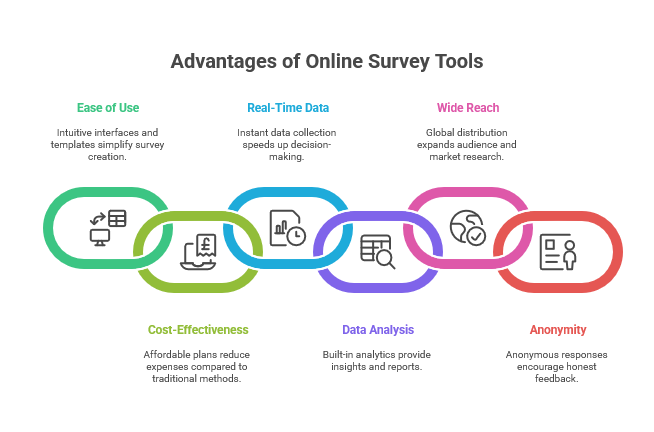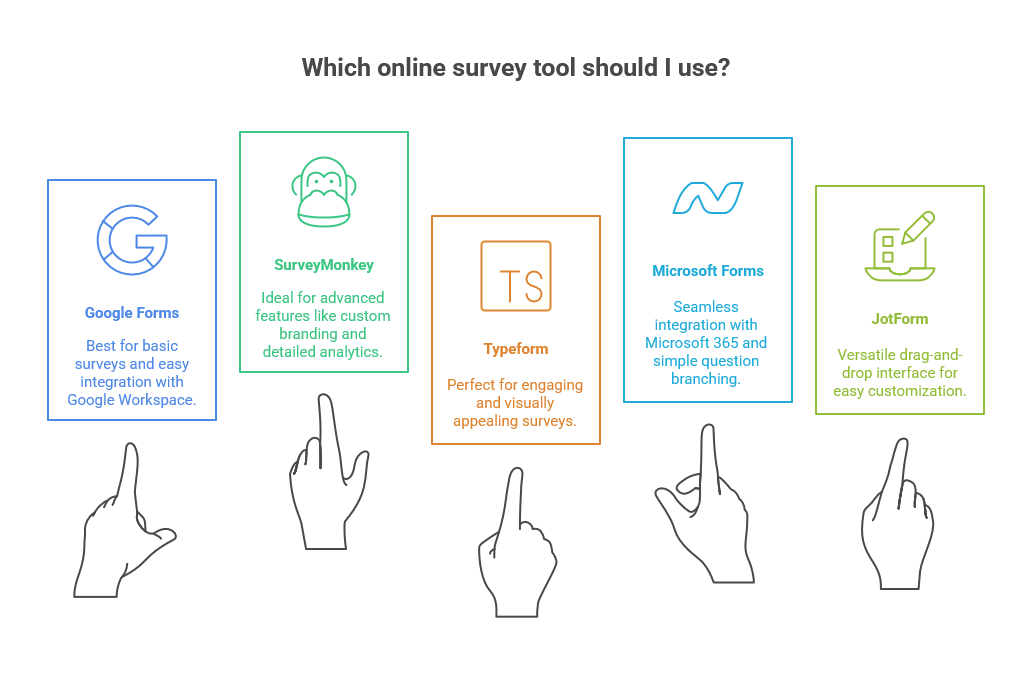Online survey tools are essential software solutions that enable individuals and organizations to create, distribute, and analyze surveys via the Internet. These tools have revolutionized data gathering, as they allow users to connect with respondents from different geographical locations instantly. Whether you’re a business owner, researcher, or educator, online survey tools make it easy to collect feedback and valuable insights.
The flexibility, convenience, and cost-effectiveness of online surveys have made them increasingly popular in today’s digital world. They help businesses and organizations make data-driven decisions by simplifying the process of collecting opinions, conducting market research, gathering customer feedback, or measuring employee satisfaction. In this article, we will explore what online survey tools are, how they work, and why they are crucial for various applications.
The Evolution of Survey Tools
Before the rise of the internet, surveys were conducted on paper, often taking weeks or even months to distribute and analyze. The development of online survey tools, however, has made it possible to collect data quickly and efficiently, revolutionizing research and feedback collection.
In the early 2000s, online surveys gained momentum with the introduction of platforms like SurveyMonkey. Since then, several other survey tools have entered the market, each offering unique features aimed at improving user experience and enhancing the survey process. Today, online survey tools provide far more than just simple data collection. They offer advanced analytics, customization options, integration with other software tools, and automated workflows, making them indispensable for businesses, educational institutions, and organizations worldwide.
Why Use Online Survey Tools?
There are several reasons why online survey tools are an essential resource for gathering feedback and conducting research. Some of the key advantages include:
1. Easy to Use
Online survey tools are designed with user-friendliness in mind. They often feature intuitive drag-and-drop interfaces that allow users to create surveys without needing any coding or technical expertise. Thanks to ready-made templates and customizable features, even users who are unfamiliar with survey design can quickly get the hang of it.
2. Cost-Effective
Traditional market research methods, such as focus groups or phone interviews, can be costly. Online surveys eliminate the need for these expensive processes, offering affordable or even free plans with essential survey functionalities. Many online survey platforms offer a free version, making them accessible to small businesses and individuals with limited budgets.
3. Quick and Real-Time Data Collection
One of the most significant advantages of online surveys is the ability to collect data in real time. Surveys can be distributed in minutes via email, social media, or website links, and responses can be collected instantly. This speeds up the process of data gathering and allows businesses to make decisions faster.
4. Data Analysis and Reporting
Online survey tools are not only designed for data collection; they also provide built-in analytics and reporting features. These tools automatically analyze the responses and generate charts, graphs, and reports that help users interpret the data. This can save hours of manual analysis and make it easier to identify trends, patterns, and insights.
5. Wide Reach
Unlike traditional surveys, which require physical distribution, online surveys can be sent to thousands of respondents across the globe. This is particularly useful for reaching a larger audience or conducting market research in diverse locations. Many online survey tools offer multi-language support, making them ideal for international audiences.
6. Anonymous Responses
Respondents often feel more comfortable answering sensitive questions anonymously. Online survey tools allow participants to provide feedback without revealing their identity, ensuring they can answer truthfully without fear of judgment. This anonymity often leads to more honest and accurate responses.

Key Features of Online Survey Tools
Online survey tools come with a range of features designed to enhance the user experience, ensure accurate data collection, and streamline the analysis process. Some of the essential features include:
1. Customizable Templates
Most online survey tools come with pre-designed templates that users can customize to fit their needs. Templates save time and make it easier to get started, especially for those who may not be familiar with survey design. Whether you’re creating a customer satisfaction survey, an employee engagement survey, or a product feedback form, there is likely a template that fits your purpose.
2. Question Variety
Online survey tools typically offer a variety of question formats. Some common types of questions include:
- Multiple choice: Respondents select one or more options from a list.
- Rating scale: Respondents rate something on a numerical scale (e.g., from 1 to 5).
- Open-ended: Respondents provide written responses.
- Dropdowns: Respondents choose from a list in a drop-down menu.
- Likert scale: Respondents choose options along a scale of agreement or frequency (e.g., strongly agree, agree, neutral, disagree, strongly disagree).
3. Skip Logic
Skip logic allows survey creators to customize the flow of the survey based on respondents’ answers. For example, if a participant answers a question negatively, they can be automatically directed to a follow-up question that is more relevant to their response. This improves the survey experience by ensuring respondents only answer questions that apply to them.
4. Mobile Compatibility
With the increasing use of smartphones, ensuring your survey is mobile-friendly is crucial. Most online survey tools are optimized for mobile devices, which means respondents can easily complete surveys on their phones, tablets, or other portable devices.
5. Data Export
Once the survey is complete, users can export the results in various formats, such as Excel, CSV, or PDF. This flexibility allows users to analyze and manipulate the data further using their preferred tools.
Types of Online Survey Tools
There are many online survey tools available, each offering unique features and capabilities. Some of the most popular platforms include:
1. Google Forms
Google Forms is one of the most widely used free survey tools. It integrates with Google Workspace applications like Google Sheets, making data analysis easy. While it lacks some advanced features found in premium tools, Google Forms is an excellent choice for basic surveys.
2. SurveyMonkey
SurveyMonkey is a powerful survey tool that offers advanced features such as custom branding, question randomization, and detailed analytics. It also provides paid plans for users who need more advanced survey features. Businesses worldwide use SurveyMonkey for customer feedback, employee surveys, and market research.
3. Typeform
Typeform stands out for its highly engaging and interactive surveys. With its visually appealing design and user-friendly interface, Typeform ensures a smooth survey-taking experience. It is particularly useful for surveys that require a more creative or engaging design, such as product feedback surveys or customer satisfaction forms.
4. Microsoft Forms
Microsoft Forms is part of the Microsoft 365 suite and integrates seamlessly with other Microsoft tools. It’s a simple yet effective survey tool that offers question branching, themes, and the ability to share surveys via links, email, or QR codes.
5. JotForm
JotForm provides a versatile drag-and-drop interface, making it easy to create surveys without any technical knowledge. It supports various question types and customization options, and it’s perfect for collecting customer feedback, employee surveys, and registration forms.

Best Practices for Creating Online Surveys
Creating effective online surveys involves more than just asking questions. You need to design surveys that encourage honest, thoughtful responses. Here are some best practices for creating surveys that yield meaningful insights:
1. Define Your Objective
Before you start designing your survey, make sure you have a clear understanding of what information you want to gather. Are you measuring customer satisfaction, market preferences, or employee engagement? A well-defined objective ensures your survey questions are aligned with your goals.
2. Keep It Short and Sweet
Survey fatigue can lead to incomplete or rushed responses. Keep your survey short, ideally under 10 minutes, and only include questions that are necessary for achieving your goal. The shorter the survey, the higher the completion rate.
3. Use Clear and Concise Language
Avoid using jargon or complex terminology that may confuse your respondents. Keep your language simple, direct, and easy to understand. The goal is to get clear, accurate responses from a wide audience.
4. Test the Survey
Before launching your survey, test it on a small group of people to ensure the questions are clear and the survey functions as expected. This helps identify any issues that could impact response rates or data quality.
5. Follow Up
After sending out the survey, consider sending follow-up reminders to increase response rates. Politely encourage your audience to participate and emphasize how their feedback will be used.
Frequently Asked Questions (FAQs)
1. What is the best online survey tool for beginners?
- Google Forms is a great starting point as it is free, easy to use, and integrates with Google Sheets for data analysis.
2. Can I customize the look of my online survey?
- Yes, many online survey tools, including SurveyMonkey and Typeform, allow you to customize the design with logos, colors, and themes.
3. How do I improve my survey response rates?
- To encourage participation, keep your survey short, send reminders, and offer incentives like discounts or entry into a prize draw.
4. Can I use online survey tools for mobile surveys?
- Yes, most online survey platforms are mobile-friendly, ensuring respondents can take surveys on smartphones and tablets.
5. Are online surveys secure?
- Most reputable online survey tools offer robust security measures, such as SSL encryption, to protect respondent data.
Online survey tools are a powerful resource for collecting feedback, conducting market research, and analyzing data. Whether you are running a small business, conducting academic research, or gathering employee opinions, online surveys offer a cost-effective, fast, and efficient way to gather insights. With user-friendly features, customizable templates, and real-time data analysis, online survey tools make the process of collecting valuable information easier than ever.
By understanding the different types of online survey tools available and their key features, you can select the right platform for your needs and start collecting actionable feedback today.

